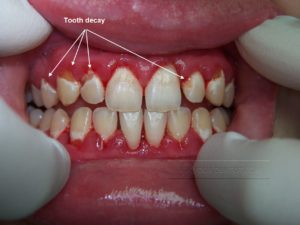Tooth decay is also known as dental caries.
It is the dissolving of the tooth surface in a slow process.
Our teeth are covered with plaque. Plaque is a thin layer of bacteria and its products. When we eat and drink sugary products, the bacteria in the plaque convert the sugar into harmful acid and other bi-products.
The longer the What is plaque? stays on our teeth and the more sugary products we consume, the quicker the decay progresses.
Tooth decay is usually found in the deep fissures (the deepest part of the chewing surface on the tooth) and between the teeth.
It is easy for plaque to build up there and it is more difficult to clean it with the toothbrush.
Symptoms:
Symptoms vary from person to person. Some people start feeling https://askyourdentist.com/sensitive-teeth/ as soon as the decay has broken the first and the hardest layer of the tooth, the enamel. Others will not feel anything even if the second and the thickest layer of the tooth, the dentine is damaged and the pulp with all the nerves and the blood vessels is infected.
How do I know that I have tooth decay?
The best way of knowing is to be examined by your dentist. The dentist takes radiographs (X-rays) of your teeth and he or she will be able to tell whether you have an established decay or early decay.

Prevention:
- Good oral hygiene, regular visits to your dentist and controlled sugar intake prevents decay from developing
- Fluoride based toothpastes and mouthwashes are recommended.
- Flossing between the teeth is also important.
To find out more and to chat one-to-one with a qualified dentist, please book an appointment here


